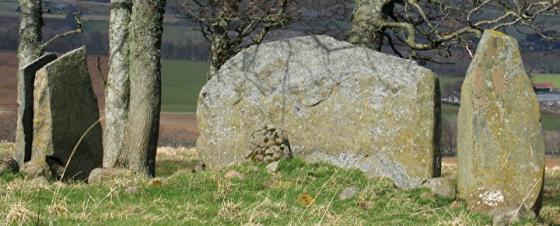The maiden of Drumdurno was the belle of five parishes, and as good as beautiful. She was young and light-hearted, and suitors came round her in plenty. One was fortunate in gaining her hand, and was received as her acknowledged lover. Her unsuccessful wooers retired disappointed, but all, with one exception, wishing long life and happiness to the “Maiden of Drumdurno,” in the new relationship on which she was about to enter. But in that heart there brooded thoughts of vengeance. A rejected suitor, wandering, one evening in the dark woods of Pittrodrie, thinking bitterly of his successful rival, exclaimed aloud -- “Oh that my eternal destruction could plague their earthly peace, how soon and sure the bargain would be mine!”
Scarcely had he uttered the rash words than a voice replied – “Capital wish! I’ll do the thing for you on your own terms!” Thus a compact, ruinous to the luckless lover of Drumdurno, and entailing “perpetual vassalage on the heedless avenger,” was entered into that night in the lone Pittrodie woods.
On the day before the wedding the maiden was busy baking cakes for the bridal feast. Her heart was light with joyful anticipations, and as she baked she gaily lilted one of the love songs of her native land.
“It sets ye well to bake, lass, gin ye had ony mair speed at it.” The bantering remark was uttered by a handsome rollicking stranger, who had been lounging about for some time, pretending to be in search of work.
“I kenna whether it sets me weel or no,” replied the maid; “but I think nane could grudge wi’ my speed.”
After some further baner, the stranger undertook to lay a “causey” to the top of the neighbouring mountain before she had finished her firlot, on condition that, if successful, her hand and heart should be his reward.
She thoughtlessly agreed to the proposal, deeming it a piece of idle fun. The stranger went on his way, and the maiden continued her task. The gloaming drew on apace, and the firlot of meal was nearly ended. The stranger and his wager were forgotten. The bride’s thoughts were all of her bridegroom, and she longed for his presence, for he had promised to be with her “twixt the gloamin’ and the mirk.”
The night came down gloomy and wet. “It’s nae that, nor mony sic like, ‘ill gar him bide frae me, but I’m wae to see him weet,” said the maiden, as she looked out to see if her lover was coming to keep his tryst; and as she spoke she glanced at the cloud gathering on the hill, when, oh horror! she saw a “well-laid causey” up the slopes of Bennachie. At the same time she beheld the stranger, who, she now discovered, was no other than the Prince of Darkness, quickly and noiselessly coming to claim his reward.
“Fast she flies, as fast pursued,
Straining for Pittrodrie wood;
‘Jamie!’ shrieks the frantic maiden,
As he wildly scours the hill.”
But alas! vain was all human aid. The unuttered prayer of her heart, however, was granted, for just as the “foul fiend” was about to clasp her in his arms, she was turned into a block of lifeless granite, and there she stands to this day.
“Lone adn last of all the clachan,
With her bake-brod and bread-spade,
Aye she bids the maids of Garioch
Guard the vows that love has made.
Love is holy, love is solemn;
Think of this mysterious column!”
The “causey” is said to be still extant, although overgrown with rank heather; and the neighbourhood bears the reputation of being haunted.
“And quick the pace, and quick the pulse,
Wha wanders there alane,
Atween Pittodrie’s haunted wood
An’ the dowie Mayden Stane.”


















































































































































































































































































